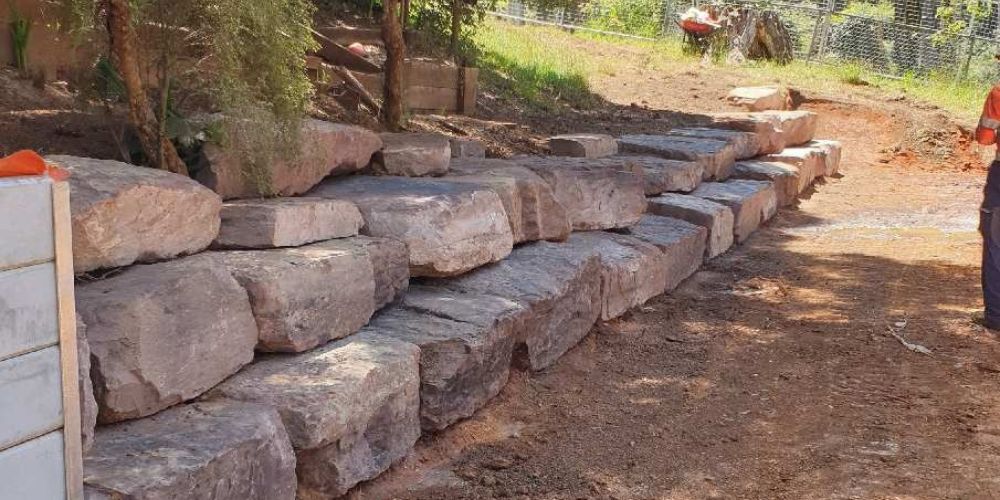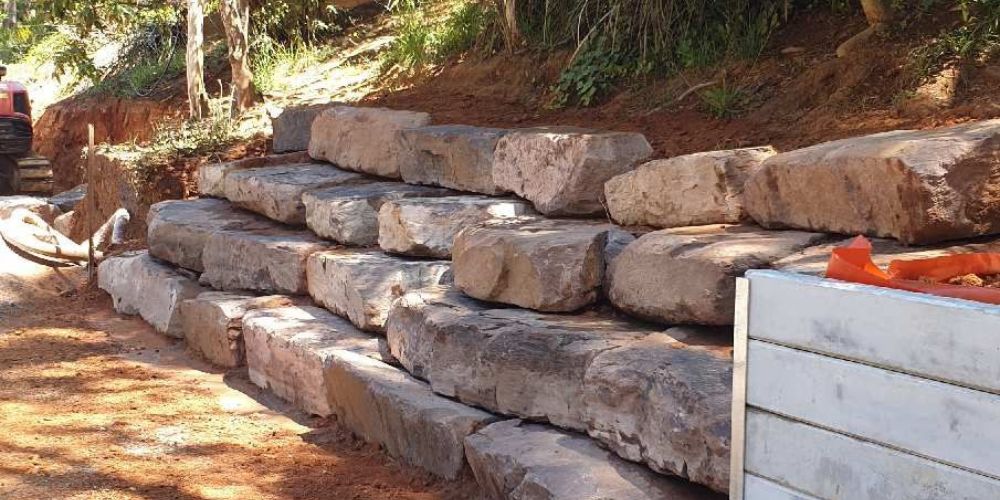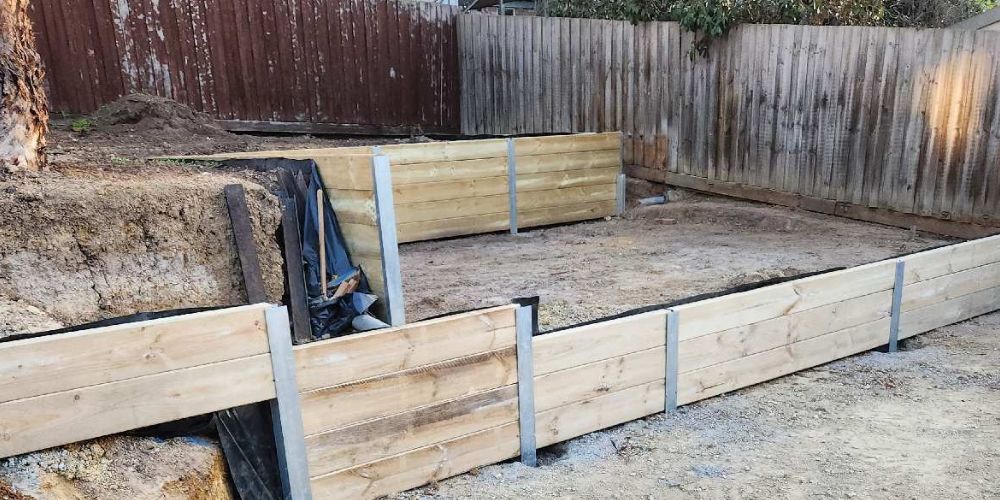How Much Weight Can a Retaining Wall Hold?
Reading Time: 6 min 50 sec

Alex
When building retaining walls, we have a lot of things to consider to identify which one we need. Though sometimes our client’s priority in mind is aesthetic, it’s only sometimes how it should be. Retaining walls serve a crucial function beyond just enhancing the visual appeal of a sustainable earthworks solution; they are essential for preventing soil erosion, controlling slopes, and providing structural support to landscapes.
In this blog, we will delve into weight capacity, a fundamental yet often overlooked aspect of retaining wall design. Understanding how much weight a retaining wall can hold is vital for ensuring its structural integrity and safeguarding property and lives.

Factors Affecting Weight Capacity of Retaining Walls
Retaining walls are engineered structures designed to withstand various forces, including the weight of soil and water they hold back. Several factors influence the weight capacity of a retaining wall, each playing a crucial role in its stability and durability.
Understanding these factors is essential for designing and constructing effective retaining walls.
Here are some of our key considerations:
Soil Type and Quality
The type of soil your wall is holding back is important. Some soils, like clay, are sticky and heavy, whereas others, like sand, are loose and light. Heavy soils impose extra strain on the wall; thus, we must consider this.
Wall Design and Construction
The way we build the wall and the materials we employ are critical. The taller and thicker the wall, the stronger it must be. It is also important to properly pack the soil behind the wall and ensure that water drains away.
Height and Length of the Wall
Think of it as building bricks. The higher and longer the wall, the more blocks are required at the bottom to hold everything up. Tall walls might need extra help, like anchors or supports, to stay sturdy.
Drainage Systems
Water can be sneaky! If it builds up behind the wall, it adds extra weight and pressure. So, we put in little holes or pipes to let the water escape. This keeps the soil from getting too soggy and heavy.
External Pressure and Load Distribution
Sometimes, things like buildings or heavy vehicles are next to the wall. They push against it, adding more pressure. We must ensure the wall can handle this extra weight without tipping over.
Environmental Factors
Nature can be tough on walls! Cold weather, earthquakes, and changes in the water level can all affect how strong the wall needs to be. We have to consider the weather and ground conditions where we’re building.
Professional Engineering Assessment
Lastly, it’s important to have experts check our work. Engineers use special tools and calculations to ensure the wall handles everything. They help us make sure the wall is safe and sturdy.

Importance of Knowing the Weight Limits of Your Retaining Walls
In our line of work, safety always comes first. That’s why understanding the weight limits of retaining walls is crucial. From the materials we choose to our design considerations, every decision revolves around ensuring that your retaining wall can bear the weight it’s meant to hold.
Safety
Exceeding a retaining wall’s weight capability can cause structural failure and collapse. This can endanger people and cause property damage.
Structural integrity
Retaining walls are built to withstand specific loads based on soil type, wall design, and building materials. Knowing the weight restrictions guarantees that the wall is structurally strong and can fulfil its intended purpose properly.
Preventing Damage
Overloading a retaining wall can cause distortion, cracking, or total failure. Adhering to weight limits can help avoid costly damage to the wall and neighbouring structures or landscape.
Legal Compliance
Building standards and regulations frequently include maximum weight limitations for retaining walls to guarantee public safety. Failure to follow these regulations may result in fines, penalties, or legal ramifications.
Longevity
Retaining walls subjected to loads that exceed their capacity are more likely to deteriorate early. Knowing the weight restrictions and adhering to them extends the life of the wall and eliminates the need for costly repairs or replacements.
Peace of Mind
Understanding the weight restrictions of your retaining walls will give you peace of mind, knowing that your property is secure and protected. You can use the space behind the wall without fear of potential threats or failures.
| Retaining Wall Type | Capacity | Height Range | Example |
|---|---|---|---|
| Gravity Walls | Use weight to withstand soil pressure | 3 to 4 feet | Stacked stone retaining walls in landscaping |
| Cantilever Walls | Disperse pressure along length | 10 to 25 feet | Highway retaining walls with extended concrete base |
| Anchored Walls | Have extra support from anchors | Exceeding 40 feet | Retaining walls with anchors installed at downward angles into soil |
Retaining walls come in different types, each with its capacity for holding weight.
Gravity Walls
These walls use their weight to withstand the soil pressure behind them. They act as a heavy block, preventing the soil from moving. Gravity walls can support a large amount of weight since they are designed to be strong and sturdy. Gravity walls typically range from 3 to 4 feet in height without additional reinforcement. Taller gravity walls may require setbacks or special engineering.
A common example of a gravity wall is a stacked stone retaining wall used in landscaping. These walls rely on the weight of the stones to resist soil pressure.
Cantilever Walls
Cantilever walls have a large base and a long arm that extends back into the soil. They function similarly to a diving board, relying on the ground for support. These walls can support significant weight because they disperse pressure along their length.
Cantilever walls can range in height from 10 to 25 feet without additional support. The cantilever arm typically extends back into the soil by one-third to one-half of the wall’s height.
Many highway retaining walls are cantilever walls. They use a thick concrete base with an extended arm to support the weight of the earth beside the road.
Anchored Walls
Anchored walls are like cantilever walls, but they have extra support in the form of anchors that go into the ground behind the wall. These anchors help spread the weight and hold the wall in place, allowing it to handle even heavier loads.
Anchored walls can reach heights exceeding 40 feet or more. The anchors are typically installed at a downward angle of about 15 to 30 degrees into the soil behind the wall.
Reinforced Soil Walls
These walls use layers of soil and reinforcements, like strips of fabric or metal, to hold back the earth. It’s like adding extra muscles to the wall. Reinforced soil walls can handle much weight by distributing it evenly through the soil and reinforcements.
Reinforced soil walls vary widely, ranging from a few feet to over 50 feet tall. The reinforcement layers are spaced horizontally throughout the wall and extend into the soil behind it.

How To Know What Retaining Wall Capacity Do You Need?
As a retaining wall builder, determining the capacity you need for your retaining wall is a critical step in the construction process. Here’s how to assess and calculate the appropriate capacity:
Understand your needs
Begin by understanding the purpose of your retaining wall. Do you want to prevent soil erosion in your garden, build level terraces on sloped land, or support a road or structure? Identifying your specific requirements can help you determine the necessary capacity.
Assess the site
Assess the circumstances on the site where the retaining wall will be built. Consider the soil type, slope gradient, groundwater levels, and any existing structures or utilities nearby. These site factors will affect the load and pressure the retaining wall must endure.
Consult with professionals
Engage with professional engineers or geotechnical specialists to evaluate the site and advise on design and capacity requirements. They can conduct soil tests, analyse site conditions, and determine the suitable capacity using industry standards and local building rules.
Consider the potential loads
Determine any potential loads or pressures the retaining wall will have to withstand. This comprises the weight of the maintained soil or material and any additional surcharge loads caused by structures, cars, or landscaping elements near the wall.
Choose the right type of retaining wall
Select a retaining wall design that best meets your demands and site conditions. Gravity walls, cantilever walls, anchored walls, and reinforced soil walls all have varying capacities and are appropriate for various applications. Choosing the right sort of wall ensures it can withstand the requisite loads.
Consider safety margin
Designing the retaining wall with safety margins is critical to accommodate uncertainties and potential changes in site circumstances. Building additional capacity beyond the minimum needs will provide a safety buffer while ensuring the wall’s long-term durability and performance.
Your wall thickness is also something you don’t want to miss taking into consideration. Designing the retaining wall with safety margins is critical to accommodate uncertainties and potential changes in site circumstances. Ensuring sufficient wall thickness is essential for structural support and stability, particularly in areas with challenging soil conditions or higher loads.
You might want to check out our blog about retaining wall thickness.
Follow building codes and standards
When designing and constructing the retaining wall, adhere to relevant building codes, regulations, and industry standards. These codes specify minimum requirements for wall height, reinforcement, drainage, and safety factors to ensure structural integrity and public safety.
Frequently Asked Questions
Depending on the wall’s design and condition, it may be possible to increase its capacity through reinforcement or retrofitting techniques. However, it’s essential to consult with a professional to assess the feasibility and safety of such modifications.
Exceeding the weight capacity of a retaining wall can lead to structural failure, such as leaning, cracking, or collapsing. This poses safety risks to people and property nearby and may result in costly repairs or replacements.
Building codes and regulations often specify minimum requirements for retaining wall design, construction, and capacity to ensure public safety. It’s essential to comply with these regulations and obtain necessary permits before building or modifying a retaining wall.
Conclusion
Knowing how much weight your retaining wall can hold is important for keeping your property safe and secure. By understanding factors like soil type, wall design, and site conditions, you can make smart decisions when building or maintaining your retaining wall.
Remember, retaining walls aren’t just for looks—they are crucial in preventing soil erosion and stabilising your landscape. By following safety guidelines, getting expert advice, and staying on top of maintenance, you can ensure that your retaining wall stays strong and reliable for the long haul.
So, whether you’re building a new wall or checking on an existing one, ensure you know its weight capacity. It’s the key to keeping your property protected and your peace of mind intact.

